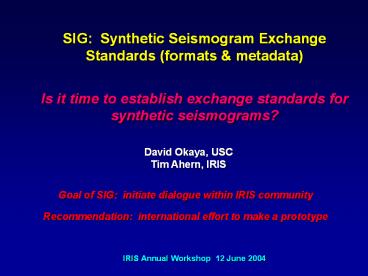SIG: Synthetic Seismogram Exchange Standards (formats - PowerPoint PPT Presentation
Title:
SIG: Synthetic Seismogram Exchange Standards (formats
Description:
Interoperatbility with upcoming digital and information technologies: - digital libraries. ... volumes (3D) over time (4D for movies). Volumes: # nodes / dim. ... – PowerPoint PPT presentation
Number of Views:310
Avg rating:3.0/5.0
Title: SIG: Synthetic Seismogram Exchange Standards (formats
1
SIG Synthetic Seismogram Exchange Standards
(formats metadata) Is it time to establish
exchange standards for synthetic seismograms?
David Okaya, USC Tim Ahern, IRIS
IRIS Annual Workshop 12 June 2004
2
SIG Synthetics Exchange Standards
David Okaya Why an Exchange Standard? Dogan
Seber Importance of Metadata for
Synthetics Linus Kamb But we have a standard --
Can SEED support synthetics? Seiji
Tsuboi XML-SEED its application to
synthetic seismogram database Torild van
Eck FDSN perspective on synthetics Heiner
Igel SPICE efforts on synthetics
Discussion
3
Why an Exchange Standard?
Archive and exchange between seismologists,
geoscientists and (civil/earthquake) engineers.
Interoperatbility with upcoming digital and
information technologies - digital
libraries. - interdisciplinary
cross-correlations. - data and metadata
searching, mining (KRR). - visualization
methods from Computer Sciences.
NSF-Cyberinfrastructure (e.g., GEON, SCEC/ITR)
international efforts such as SPICE.
4
Characteristics of Synthetic Seismograms
Volumes nodes / dim. dimensions
components
5
What Exists Now?
Traditional SAC, AH, SEGY, CSS, ascii, raw
binary, readme
pros known formats, familiar to communities,
translators exist. cons limited metadata,
limited use for 3D/4D.
SEED/miniSEED
pros infrastructure already exists for
archive/distribution translators,
utilities. cons lacks familiarity within
synthetics community needs alteration for
higher D and metadata.
Other forms e.g., netCDF
pros established use within other natural
sciences engineering useful for computer
interoperatbility. cons "non-seismological"
little opportunity to adjust.
6
What Do We Need?
7
Example SCEC/ITR Use of Synthetics
SCEC/ITR is a 10M / 5-year Information
Technology project. Collaboration between
SCEC, USGS, IRIS, with SDSC, ISI. PIs T.
Jordan, J.B. Minster, R. Moore, C. Kesselman.
"Community Modeling Environment" (CME) -
Develop for broad audience an integrated
information infrastructure for earthquake
science. - Grid computing, digital libraries,
KRR, visualization. Role of Synthetics -
Physics-based simulation of ground motion for
seismic hazard analysis. - Takes into account
wave propagation through 3D structure, source
dynamics, and (non)-linear site effects.
8
SCEC/ITR Community Modeling Environment
9
(No Transcript)
10
Do We Need a Standard?
For individual work, not necessarily. Useful
for exchange among seismologists. Essential
for IT interoperability.
11
SIG Synthetics Exchange Standards
David Okaya Why an Exchange Standard? Dogan
Seber Importance of Metadata for
Synthetics Linus Kamb But we have a standard --
Can SEED support synthetics? Seiji
Tsuboi XML-SEED its application to
synthetic seismogram database Torild van
Eck FDSN perspective on synthetics Heiner
Igel SPICE efforts on synthetics
Discussion































